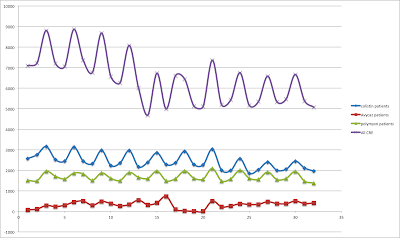 Its Davos time again – or at least it was last week. During
the Davos meeting, the final DRIVE AB report
was released where pull incentives were highlighted. A report
from the AMR Industry Alliance was also published focusing on the fight against resistance by industry. But at the meeting itself, almost
nothing was said regarding resistance and incentives as far as I can tell by
looking at the publicly available highlights
for the conference. (Needless to say, I
was not there).
Its Davos time again – or at least it was last week. During
the Davos meeting, the final DRIVE AB report
was released where pull incentives were highlighted. A report
from the AMR Industry Alliance was also published focusing on the fight against resistance by industry. But at the meeting itself, almost
nothing was said regarding resistance and incentives as far as I can tell by
looking at the publicly available highlights
for the conference. (Needless to say, I
was not there).
The AMR Industry Alliance report was interpreted by some as saying that GSK
and J&J are leading the effort in the fight against resistance. I did not interpret it that way. The report did say that both companies are
opening some of their data to public collaborations – but that does not mean
they are ahead in the fight against resistance. In my own view of the industry
in this regard, there are companies like Entasis with both strong clinical and
preclinical efforts that probably deserve better ratings than GSK and J&J.
One clear message from both Drive AB and from the AMR
Industry Alliance was that pull incentives are desperately needed and that,
there, no one has seen much progress.
Yes – there has been a lot of writing in many publications, position
papers, white papers. Folks like us have been talking among ourselves. My friend John Rex keeps saying that ten years ago we never dreamed we would be having these conversations - and he is right. But in terms of concrete action – no one is
seeing anything.
 This brings me to Merck and the recent announcement of the
spinoff of many of its preclinical assets in the antibiotic space, Prokaryotics. Wow! This looks like a good team. Terry Roemer is leading the science and Keith
Bostian is the CEO. I invite you all to look at their website. BUT
– what does this say about Merck? To me it says that with its acquisition of
Cubist and its products in the marketplace like ceftolozane-tazobactam,
tedizolid and its pipeline compound, imipenem-cilastatin-relebactam, they have
had it with the antibiotics space. They do not want to dig themselves a deeper
hole. And without clear pull incentives, the rest of the industry is going to
follow in their footsteps and of those of the Medicines Company and so many others
over the last 20 years.
This brings me to Merck and the recent announcement of the
spinoff of many of its preclinical assets in the antibiotic space, Prokaryotics. Wow! This looks like a good team. Terry Roemer is leading the science and Keith
Bostian is the CEO. I invite you all to look at their website. BUT
– what does this say about Merck? To me it says that with its acquisition of
Cubist and its products in the marketplace like ceftolozane-tazobactam,
tedizolid and its pipeline compound, imipenem-cilastatin-relebactam, they have
had it with the antibiotics space. They do not want to dig themselves a deeper
hole. And without clear pull incentives, the rest of the industry is going to
follow in their footsteps and of those of the Medicines Company and so many others
over the last 20 years.
The AMR Industry Alliance called on all stakeholders to “move
beyond statements of intent and to take concrete action to address AMR.” Amen. Of course, it has not been like there
has been no action. We have a good deal
of money for push incentives – take CARB-X
as an example. But when it comes to the strategy that will be the most costly
and yet is the most desperately needed, pull incentives, we are nowhere.
The antibiotics market is broken. It requires financial
intervention in the form of pull incentives to assure the continued availability of new antibiotics active
against ever-emerging resistant pathogens. Without this intervention we will
all be stuck talking to ourselves on the deck of a very large Titanic.








